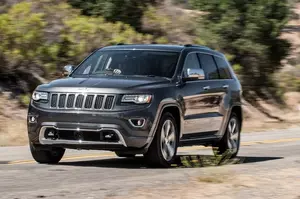
| Vehicle | Curb weight | Difference from world's smallest | Weight to power ratio | 0—60 mph acceleration ratio | Consumption ratio |
|---|---|---|---|---|---|
| 3.0 V6 MultiJet |
2328 kg / 5133 lbs |
1903 kg (4196 lbs) heavier | 9 kg to 1 hp | 298 kg/s (657 lbs/s) |
333 kg/L (734 lbs/L) |
| 3.6 V6 |
2191 kg / 4831 lbs |
1766 kg (3894 lbs) heavier | 8 kg to 1 hp | 277 kg/s (611 lbs/s) |
219 kg/L (483 lbs/L) |
| SRT 6.4 V8 |
2343 kg / 5166 lbs |
1918 kg (4229 lbs) heavier | 5 kg to 1 hp | 488 kg/s (1076 lbs/s) |
174 kg/L (384 lbs/L) |
| 5.7 V8 |
2307 kg / 5087 lbs |
1882 kg (4150 lbs) heavier | 7 kg to 1 hp | 334 kg/s (736 lbs/s) |
177 kg/L (390 lbs/L) |
| Trackhawk 6.2 V8 |
2433 kg / 5365 lbs |
2008 kg (4428 lbs) heavier | 3 kg to 1 hp | - | - |
| Vehicle | 3.0 V6 MultiJet |
|---|---|
| Curb weight |
2328 kg / 5133 lbs |
| Difference from world's smallest | 1903 kg (1903 lbs) heavier |
| Weight to power ratio | 9 kg to 1 hp |
| 0—60 mph acceleration ratio | 298 kg/s (657 lbs/s) |
| Consumption ratio |
333 kg/L (734 lbs/L) |
| Vehicle | 3.6 V6 |
| Curb weight |
2191 kg / 4831 lbs |
| Difference from world's smallest | 1766 kg (1766 lbs) heavier |
| Weight to power ratio | 8 kg to 1 hp |
| 0—60 mph acceleration ratio | 277 kg/s (611 lbs/s) |
| Consumption ratio |
219 kg/L (483 lbs/L) |
| Vehicle | SRT 6.4 V8 |
| Curb weight |
2343 kg / 5166 lbs |
| Difference from world's smallest | 1918 kg (1918 lbs) heavier |
| Weight to power ratio | 5 kg to 1 hp |
| 0—60 mph acceleration ratio | 488 kg/s (1076 lbs/s) |
| Consumption ratio |
174 kg/L (384 lbs/L) |
| Vehicle | 5.7 V8 |
| Curb weight |
2307 kg / 5087 lbs |
| Difference from world's smallest | 1882 kg (1882 lbs) heavier |
| Weight to power ratio | 7 kg to 1 hp |
| 0—60 mph acceleration ratio | 334 kg/s (736 lbs/s) |
| Consumption ratio |
177 kg/L (390 lbs/L) |
| Vehicle | Trackhawk 6.2 V8 |
| Curb weight |
2433 kg / 5365 lbs |
| Difference from world's smallest | 2008 kg (2008 lbs) heavier |
| Weight to power ratio | 3 kg to 1 hp |
| 0—60 mph acceleration ratio | - |
| Consumption ratio | - |

| Vehicle | Curb weight | Difference from world's smallest | Weight to power ratio | 0—60 mph acceleration ratio | Consumption ratio |
|---|---|---|---|---|---|
| 3.0 CRD |
2403 kg / 5299 lbs |
1978 kg (4362 lbs) heavier | 10 kg to 1 hp | 308 kg/s (679 lbs/s) |
320 kg/L (706 lbs/L) |
| 3.6 V6 |
2121 kg / 4677 lbs |
1696 kg (3740 lbs) heavier | 7 kg to 1 hp | - | - |
| 5.7 V8 |
2329 kg / 5135 lbs |
1904 kg (4198 lbs) heavier | 6 kg to 1 hp | - |
158 kg/L (348 lbs/L) |
| SRT8 6.4 V8 |
2342 kg / 5164 lbs |
1917 kg (4227 lbs) heavier | 5 kg to 1 hp | 488 kg/s (1076 lbs/s) |
167 kg/L (368 lbs/L) |
| 3.0 EcoDiesel |
2393 kg / 5277 lbs |
1968 kg (4340 lbs) heavier | 10 kg to 1 hp | - |
244 kg/L (538 lbs/L) |
| SRT 6.4 V8 |
2336 kg / 5151 lbs |
1911 kg (4214 lbs) heavier | 5 kg to 1 hp | - |
149 kg/L (329 lbs/L) |
| Vehicle | 3.0 CRD |
|---|---|
| Curb weight |
2403 kg / 5299 lbs |
| Difference from world's smallest | 1978 kg (1978 lbs) heavier |
| Weight to power ratio | 10 kg to 1 hp |
| 0—60 mph acceleration ratio | 308 kg/s (679 lbs/s) |
| Consumption ratio |
320 kg/L (706 lbs/L) |
| Vehicle | 3.6 V6 |
| Curb weight |
2121 kg / 4677 lbs |
| Difference from world's smallest | 1696 kg (1696 lbs) heavier |
| Weight to power ratio | 7 kg to 1 hp |
| 0—60 mph acceleration ratio | - |
| Consumption ratio | - |
| Vehicle | 5.7 V8 |
| Curb weight |
2329 kg / 5135 lbs |
| Difference from world's smallest | 1904 kg (1904 lbs) heavier |
| Weight to power ratio | 6 kg to 1 hp |
| 0—60 mph acceleration ratio | - |
| Consumption ratio |
158 kg/L (348 lbs/L) |
| Vehicle | SRT8 6.4 V8 |
| Curb weight |
2342 kg / 5164 lbs |
| Difference from world's smallest | 1917 kg (1917 lbs) heavier |
| Weight to power ratio | 5 kg to 1 hp |
| 0—60 mph acceleration ratio | 488 kg/s (1076 lbs/s) |
| Consumption ratio |
167 kg/L (368 lbs/L) |
| Vehicle | 3.0 EcoDiesel |
| Curb weight |
2393 kg / 5277 lbs |
| Difference from world's smallest | 1968 kg (1968 lbs) heavier |
| Weight to power ratio | 10 kg to 1 hp |
| 0—60 mph acceleration ratio | - |
| Consumption ratio |
244 kg/L (538 lbs/L) |
| Vehicle | SRT 6.4 V8 |
| Curb weight |
2336 kg / 5151 lbs |
| Difference from world's smallest | 1911 kg (1911 lbs) heavier |
| Weight to power ratio | 5 kg to 1 hp |
| 0—60 mph acceleration ratio | - |
| Consumption ratio |
149 kg/L (329 lbs/L) |
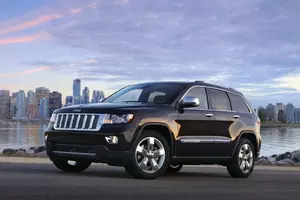
| Vehicle | Curb weight | Difference from world's smallest | Weight to power ratio | 0—60 mph acceleration ratio | Consumption ratio |
|---|---|---|---|---|---|
| 3.0 CRD |
2272 kg / 5010 lbs |
1847 kg (4073 lbs) heavier | 12 kg to 1 hp | 234 kg/s (516 lbs/s) |
274 kg/L (604 lbs/L) |
| 3.6 V6 |
2114 kg / 4661 lbs |
1689 kg (3724 lbs) heavier | 7 kg to 1 hp | - |
161 kg/L (355 lbs/L) |
| 5.7 V8 |
2278 kg / 5023 lbs |
1853 kg (4086 lbs) heavier | 6 kg to 1 hp | - |
145 kg/L (320 lbs/L) |
| SRT8 6.4 V8 |
2336 kg / 5151 lbs |
1911 kg (4214 lbs) heavier | 5 kg to 1 hp | 487 kg/s (1074 lbs/s) |
139 kg/L (306 lbs/L) |
| Vehicle | 3.0 CRD |
|---|---|
| Curb weight |
2272 kg / 5010 lbs |
| Difference from world's smallest | 1847 kg (1847 lbs) heavier |
| Weight to power ratio | 12 kg to 1 hp |
| 0—60 mph acceleration ratio | 234 kg/s (516 lbs/s) |
| Consumption ratio |
274 kg/L (604 lbs/L) |
| Vehicle | 3.6 V6 |
| Curb weight |
2114 kg / 4661 lbs |
| Difference from world's smallest | 1689 kg (1689 lbs) heavier |
| Weight to power ratio | 7 kg to 1 hp |
| 0—60 mph acceleration ratio | - |
| Consumption ratio |
161 kg/L (355 lbs/L) |
| Vehicle | 5.7 V8 |
| Curb weight |
2278 kg / 5023 lbs |
| Difference from world's smallest | 1853 kg (1853 lbs) heavier |
| Weight to power ratio | 6 kg to 1 hp |
| 0—60 mph acceleration ratio | - |
| Consumption ratio |
145 kg/L (320 lbs/L) |
| Vehicle | SRT8 6.4 V8 |
| Curb weight |
2336 kg / 5151 lbs |
| Difference from world's smallest | 1911 kg (1911 lbs) heavier |
| Weight to power ratio | 5 kg to 1 hp |
| 0—60 mph acceleration ratio | 487 kg/s (1074 lbs/s) |
| Consumption ratio |
139 kg/L (306 lbs/L) |
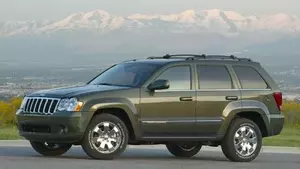
| Vehicle | Curb weight | Difference from world's smallest | Weight to power ratio | 0—60 mph acceleration ratio | Consumption ratio |
|---|---|---|---|---|---|
| 5.7i V8 |
2175 kg / 4796 lbs |
1750 kg (3859 lbs) heavier | 7 kg to 1 hp | 311 kg/s (686 lbs/s) |
141 kg/L (311 lbs/L) |
| 4.7i V8 |
2092 kg / 4613 lbs |
1667 kg (3676 lbs) heavier | 9 kg to 1 hp | - | - |
| 3.0 CRD |
2135 kg / 4708 lbs |
1710 kg (3771 lbs) heavier | 10 kg to 1 hp | 248 kg/s (547 lbs/s) |
209 kg/L (461 lbs/L) |
| 3.7i V6 |
2014 kg / 4441 lbs |
1589 kg (3504 lbs) heavier | 9 kg to 1 hp | - |
154 kg/L (340 lbs/L) |
| SRT8 6.1i V8 |
2145 kg / 4730 lbs |
1720 kg (3793 lbs) heavier | 5 kg to 1 hp | 447 kg/s (986 lbs/s) |
134 kg/L (295 lbs/L) |
| Vehicle | 5.7i V8 |
|---|---|
| Curb weight |
2175 kg / 4796 lbs |
| Difference from world's smallest | 1750 kg (1750 lbs) heavier |
| Weight to power ratio | 7 kg to 1 hp |
| 0—60 mph acceleration ratio | 311 kg/s (686 lbs/s) |
| Consumption ratio |
141 kg/L (311 lbs/L) |
| Vehicle | 4.7i V8 |
| Curb weight |
2092 kg / 4613 lbs |
| Difference from world's smallest | 1667 kg (1667 lbs) heavier |
| Weight to power ratio | 9 kg to 1 hp |
| 0—60 mph acceleration ratio | - |
| Consumption ratio | - |
| Vehicle | 3.0 CRD |
| Curb weight |
2135 kg / 4708 lbs |
| Difference from world's smallest | 1710 kg (1710 lbs) heavier |
| Weight to power ratio | 10 kg to 1 hp |
| 0—60 mph acceleration ratio | 248 kg/s (547 lbs/s) |
| Consumption ratio |
209 kg/L (461 lbs/L) |
| Vehicle | 3.7i V6 |
| Curb weight |
2014 kg / 4441 lbs |
| Difference from world's smallest | 1589 kg (1589 lbs) heavier |
| Weight to power ratio | 9 kg to 1 hp |
| 0—60 mph acceleration ratio | - |
| Consumption ratio |
154 kg/L (340 lbs/L) |
| Vehicle | SRT8 6.1i V8 |
| Curb weight |
2145 kg / 4730 lbs |
| Difference from world's smallest | 1720 kg (1720 lbs) heavier |
| Weight to power ratio | 5 kg to 1 hp |
| 0—60 mph acceleration ratio | 447 kg/s (986 lbs/s) |
| Consumption ratio |
134 kg/L (295 lbs/L) |
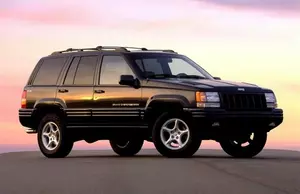
| Vehicle | Curb weight | Difference from world's smallest | Weight to power ratio | 0—60 mph acceleration ratio | Consumption ratio |
|---|---|---|---|---|---|
| 3.1 TD |
1856 kg / 4092 lbs |
1431 kg (3155 lbs) heavier | 13 kg to 1 hp | 140 kg/s (309 lbs/s) |
157 kg/L (346 lbs/L) |
| 4.0i |
1806 kg / 3982 lbs |
1381 kg (3045 lbs) heavier | 10 kg to 1 hp | 174 kg/s (384 lbs/s) |
123 kg/L (271 lbs/L) |
| 4.7i V8 |
1784 kg / 3934 lbs |
1359 kg (2997 lbs) heavier | 8 kg to 1 hp | - | - |
| 4.7 V8 |
1759 kg / 3879 lbs |
1334 kg (2942 lbs) heavier | 7 kg to 1 hp | - |
127 kg/L (280 lbs/L) |
| 4.0 |
1696 kg / 3740 lbs |
1271 kg (2803 lbs) heavier | 9 kg to 1 hp | - |
129 kg/L (284 lbs/L) |
| 2.7 CDR |
1980 kg / 4366 lbs |
1555 kg (3429 lbs) heavier | 12 kg to 1 hp | 187 kg/s (412 lbs/s) |
204 kg/L (450 lbs/L) |
| Vehicle | 3.1 TD |
|---|---|
| Curb weight |
1856 kg / 4092 lbs |
| Difference from world's smallest | 1431 kg (1431 lbs) heavier |
| Weight to power ratio | 13 kg to 1 hp |
| 0—60 mph acceleration ratio | 140 kg/s (309 lbs/s) |
| Consumption ratio |
157 kg/L (346 lbs/L) |
| Vehicle | 4.0i |
| Curb weight |
1806 kg / 3982 lbs |
| Difference from world's smallest | 1381 kg (1381 lbs) heavier |
| Weight to power ratio | 10 kg to 1 hp |
| 0—60 mph acceleration ratio | 174 kg/s (384 lbs/s) |
| Consumption ratio |
123 kg/L (271 lbs/L) |
| Vehicle | 4.7i V8 |
| Curb weight |
1784 kg / 3934 lbs |
| Difference from world's smallest | 1359 kg (1359 lbs) heavier |
| Weight to power ratio | 8 kg to 1 hp |
| 0—60 mph acceleration ratio | - |
| Consumption ratio | - |
| Vehicle | 4.7 V8 |
| Curb weight |
1759 kg / 3879 lbs |
| Difference from world's smallest | 1334 kg (1334 lbs) heavier |
| Weight to power ratio | 7 kg to 1 hp |
| 0—60 mph acceleration ratio | - |
| Consumption ratio |
127 kg/L (280 lbs/L) |
| Vehicle | 4.0 |
| Curb weight |
1696 kg / 3740 lbs |
| Difference from world's smallest | 1271 kg (1271 lbs) heavier |
| Weight to power ratio | 9 kg to 1 hp |
| 0—60 mph acceleration ratio | - |
| Consumption ratio |
129 kg/L (284 lbs/L) |
| Vehicle | 2.7 CDR |
| Curb weight |
1980 kg / 4366 lbs |
| Difference from world's smallest | 1555 kg (1555 lbs) heavier |
| Weight to power ratio | 12 kg to 1 hp |
| 0—60 mph acceleration ratio | 187 kg/s (412 lbs/s) |
| Consumption ratio |
204 kg/L (450 lbs/L) |
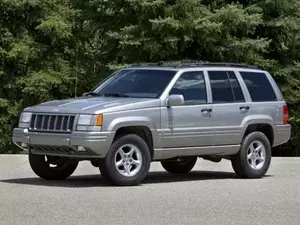
| Vehicle | Curb weight | Difference from world's smallest | Weight to power ratio | 0—60 mph acceleration ratio | Consumption ratio |
|---|---|---|---|---|---|
| 4.0i |
1735 kg / 3826 lbs |
1310 kg (2889 lbs) heavier | 10 kg to 1 hp | 162 kg/s (357 lbs/s) |
124 kg/L (273 lbs/L) |
| 5.2i V8 |
1775 kg / 3914 lbs |
1350 kg (2977 lbs) heavier | 8 kg to 1 hp | 191 kg/s (421 lbs/s) |
117 kg/L (258 lbs/L) |
| 5.9i V8 |
1933 kg / 4262 lbs |
1508 kg (3325 lbs) heavier | 8 kg to 1 hp | 248 kg/s (547 lbs/s) |
108 kg/L (238 lbs/L) |
| 2.5 TD |
1775 kg / 3914 lbs |
1350 kg (2977 lbs) heavier | 15 kg to 1 hp | 143 kg/s (315 lbs/s) |
172 kg/L (379 lbs/L) |
| Vehicle | 4.0i |
|---|---|
| Curb weight |
1735 kg / 3826 lbs |
| Difference from world's smallest | 1310 kg (1310 lbs) heavier |
| Weight to power ratio | 10 kg to 1 hp |
| 0—60 mph acceleration ratio | 162 kg/s (357 lbs/s) |
| Consumption ratio |
124 kg/L (273 lbs/L) |
| Vehicle | 5.2i V8 |
| Curb weight |
1775 kg / 3914 lbs |
| Difference from world's smallest | 1350 kg (1350 lbs) heavier |
| Weight to power ratio | 8 kg to 1 hp |
| 0—60 mph acceleration ratio | 191 kg/s (421 lbs/s) |
| Consumption ratio |
117 kg/L (258 lbs/L) |
| Vehicle | 5.9i V8 |
| Curb weight |
1933 kg / 4262 lbs |
| Difference from world's smallest | 1508 kg (1508 lbs) heavier |
| Weight to power ratio | 8 kg to 1 hp |
| 0—60 mph acceleration ratio | 248 kg/s (547 lbs/s) |
| Consumption ratio |
108 kg/L (238 lbs/L) |
| Vehicle | 2.5 TD |
| Curb weight |
1775 kg / 3914 lbs |
| Difference from world's smallest | 1350 kg (1350 lbs) heavier |
| Weight to power ratio | 15 kg to 1 hp |
| 0—60 mph acceleration ratio | 143 kg/s (315 lbs/s) |
| Consumption ratio |
172 kg/L (379 lbs/L) |